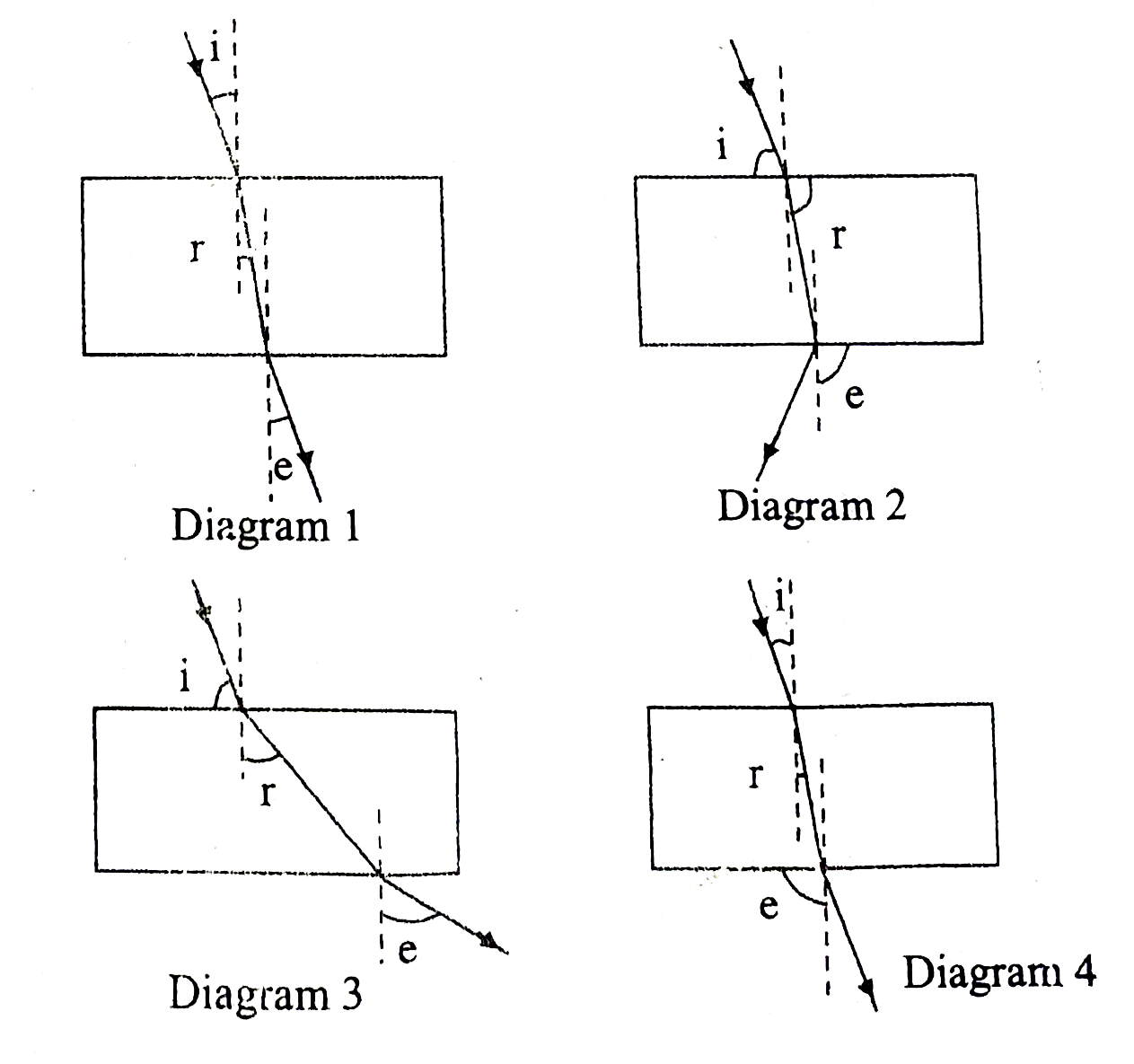A teacher asked four students to record the observations of the experiment on tracing the path of a ray of light through a rectangular glass slab. The students recorded their observations under the following headings :
(1) Angle of incidence, Angle of refraction, Angle of reflection
(2) Angle of incidence, Angle of deviation, Angle of emergence
(3) Angle of incidence, Angle of reflection, Angle of emergence
(4) Angle of incidence, Angle of refraction, Angle of emergence
The correct observations were recorded by the student :
A
B
C
D
The correct Answer is:D
NA
Topper's Solved these Questions
- BOOK - LAKHMIR SINGH & MANJIT KAURCHAPTER - THE HUMAN EYE AND THE COLOURFUL WORLD EXERCISE - Long Answer Type Question3videos
THE HUMAN EYE AND THE COLOURFUL WORLD
- BOOK - LAKHMIR SINGH & MANJIT KAURCHAPTER - THE HUMAN EYE AND THE COLOURFUL WORLD EXERCISE - NCERT Book14videos
THE HUMAN EYE AND THE COLOURFUL WORLD
- BOOK - LAKHMIR SINGH & MANJIT KAURCHAPTER - THE HUMAN EYE AND THE COLOURFUL WORLD EXERCISE - Long Answer Type Questions2videos
THE HUMAN EYE AND THE COLOURFUL WORLD
- BOOK - LAKHMIR SINGH & MANJIT KAURCHAPTER - TEST PAPER 4EXERCISE - SECTION A10videos
TEST PAPER 4
Similar Questions
In an experiment, the path of a ray of light passing through a rectangular glass slab was traced by a student. Which of the following diagram shows correct measurement of angle of incidence (i), refraction (r ), and emergence (e ) ?
 View Solution
View SolutionAmol performed an experiment on tracing the path of a ray of light passing through a rectangular glass slab. When ray of light enters from air to glass slab, he observed ∠I=45∘. The angle of refraction must be
View Solution
Knowledge Check
- Question 1 - Select One
In the experiment to trace the path of a ray of light through a parallel sided glass slab, a student measured the angles of refraction for three different angles of incidence. He will find that :
Aangle of refraction is always equal to the angle of incidenceBangle of refraction is always smaller than the angle of incidenceCangle of refraction is always greater than the angle of incidenceDangle of refraction can be smaller or greater than the angle of incidence depending on the refractive index of glass slab - Question 2 - Select One
In an experiment on tracing the path of a ray of light through a rectangular glass slab, four students A, B, C and D used the following values of the angle of incidence and the distance between the feet of the two pins (fixed on the incident rays) :
A30∘,45∘,60∘ and 1 cmB30∘,45∘,60∘ and 6 cmC20∘,50∘,80∘ and 10 cmD20∘,50∘,80∘ and 15 cm - Question 3 - Select One
In the experiment on tracing the path of a ray of light passing through a rectangular glass slab, the correct setting of the protractor (D), for measuring the angle of incidence (∠I), and the angle of emergence (∠e) correspond, respectively, to diagrams :
 AK and MBK and NCL and MDL and N
AK and MBK and NCL and MDL and N
An experiment to trace the path of a ray of light through a rectangular glass slab was performed by four students I, II, III, IV. They reported the following measurements of angle of incidence __ angle of refraction ___ and angle of emergence __ Which one of the students has performed the experiment correctly ?
 View Solution
View SolutionA student performs the experiment on tracing the path of a ray of light passing through a rectangular glass slab for different angles of incidence. He measures the angle of incidence ∠i, angle of refraction ∠r and angle of emergence ∠e for all his observations. He would find that in all cases :
View SolutionIn an experiment to trace the path of a ray of light passing through a rectangular glass slab, four students measured the angles of incidence (i), angles of refraction (r) and angles of emergence (e) as shown in the diagrams :

The correct measurement is given in the diagram :View SolutionA student does the experiment on tracing the path of a ray of light passing through a rectangular glass slab for different angles of incidence. He can get a correct measure of the angle of incidence and the angle of emergence by following the labelling indicated in figure :
 View Solution
View SolutionIn an experiment to study the refraction of light through a rectangular glass slab, a student measured the angle of incidence, angle of refraction and the angle of emergence, The student lost the reading of angle of incidence but noted the readings of angle of refraction to be 35∘ and angle of emergence to be 65∘. The angle of incidence is likely to be :
View Solution

